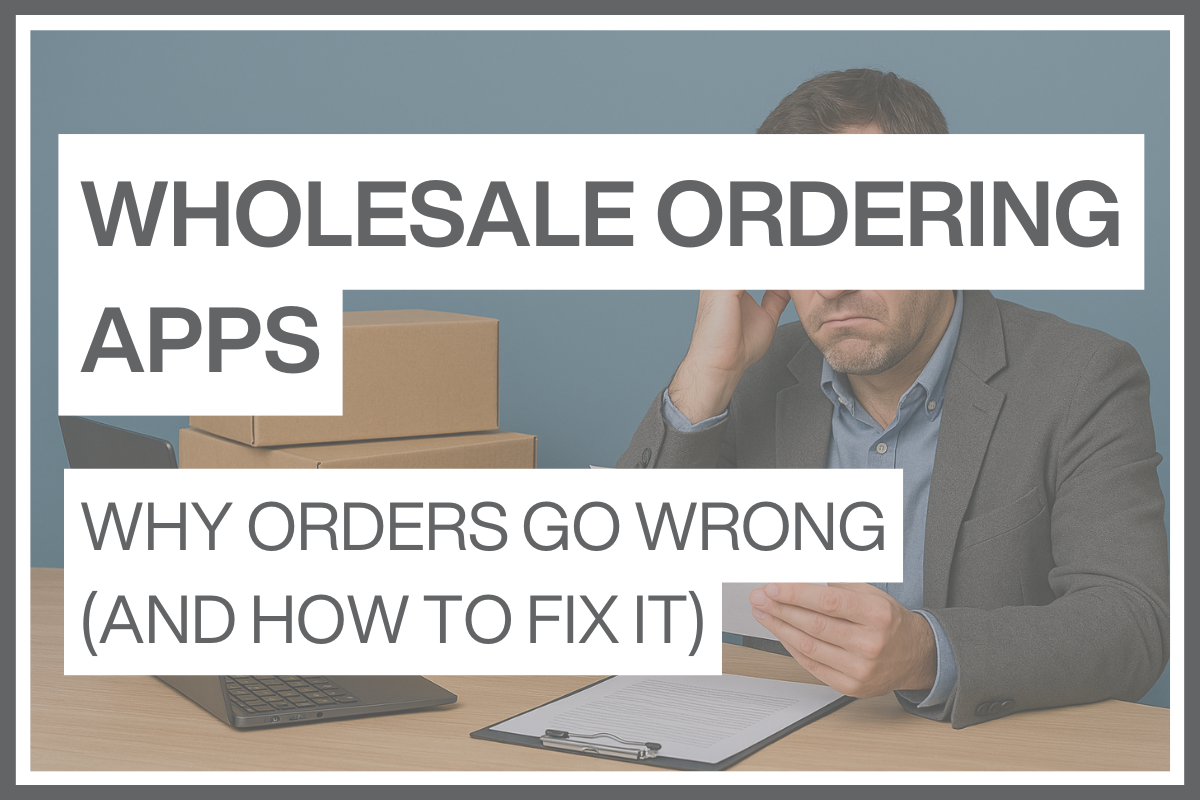Wholesale ordering apps: why orders go wrong (and how to fix it)

A wholesale ordering app should make life easier for distributors. But, for many, it hasn’t worked out that way. Orders still go missing, pricing errors slip through, and customers lose confidence. The problem isn’t effort or intent; it’s connection. Most digital tools used by wholesalers don’t talk properly to ERP systems, which means reps and customers are working from outdated or incomplete data.
Disconnected systems create frustration on all sides. Sales teams waste time chasing stock checks and price approvals, admin staff spend hours correcting mistakes, and retailers wait longer for accurate confirmations. It’s not that distributors haven’t gone digital (they have). The problem is the pieces aren’t joined up. A wholesale ordering app designed for integration can fix that, and understanding where things break down is the first step.
Why ordering mistakes still happen
Digital ordering was meant to solve the accuracy problem in wholesale, but it hasn’t. Many distributors still find that mistakes slip through. Not because their teams aren’t careful, but because their systems don’t line up. When data sits in silos, human error finds its way back in.
Most errors start with fragmented information. A rep might show a catalogue that’s out of date or process an order before stock levels refresh. Prices change, discounts expire, but the order still goes through as if nothing has changed. Somewhere else, an admin team rekeys the same order into the ERP system, introducing small typos that turn into costly corrections later.
Even when the technology feels modern, the process behind it often isn’t. Orders might move from app to spreadsheet to ERP, passing through multiple hands along the way. Every extra step increases the risk of something going wrong; wrong product, wrong price, wrong quantity. And while these mistakes might seem minor, they add up quickly when hundreds of orders are processed each week.
The problem isn’t people; it’s process. Without live data and connected systems, digital tools simply shift the same old problems into a new format.
- Stock accuracy has shifted from warehouse issue to sales priority
- Buyers expect instant confirmation of availability
- Reps lose credibility if they hedge or delay
The cost of getting it wrong
Every incorrect order chips away at profit. It’s rarely just the replacement cost; it’s the time spent fixing mistakes, the rework in the warehouse, the credit notes, and the follow-up calls that eat into margins. By the time the error is corrected, the original sale has already cost more to fulfil than it was worth.
Distributors see this pattern all the time. A small error (one wrong product code or price line) creates a chain reaction across departments. Sales teams chase updates, warehouse staff recheck stock, finance processes refunds, and customer service handles complaints. The business stays busy, but not in a productive way.
The financial impact adds up fast. Studies show that order errors can reduce turnover by 2–4% a year, once admin, rework, and goodwill discounts are included. For many distributors, that’s the difference between a strong quarter and a missed target.
Beyond the numbers, there’s the customer impact. Retailers under pressure don’t want excuses; they want reliability. If they can’t trust the accuracy of your orders, they’ll look elsewhere. Even if your prices are competitive. Getting orders right first time protects both profit and reputation.
- Order errors cost more than just replacements — they drain time and margin
- Small mistakes trigger delays across sales, warehouse and finance teams
- Lost trust costs more than lost stock — reliability drives retention
Where digital falls short
Many distributors already use online portals or basic mobile ordering tools. But the gap between “digital” and “efficient” is still wide. On the surface, these tools seem to modernise the process: orders arrive electronically, customers submit requests online, and reps no longer rely on handwritten notes. Yet underneath, the same old inefficiencies remain. They’ve just moved into a new format.
The problem is most of these systems act as digital forms, not connected platforms. They collect orders but don’t communicate with ERP systems in real time. That means stock levels are often out of date by the time the order is placed, or customer pricing isn’t applied correctly. Reps might think they’re capturing accurate data, but if the information feeding the app isn’t current, every order risks being wrong before it even reaches the back office.
What happens next is all too familiar. Someone in admin must export, check, and re-enter those orders manually. Every duplicate step introduces delay and increases the chance of human error. It also means your team is spending more time fixing process gaps than selling. So while the interface looks sleek, the workflow behind it still belongs to another era, and it shows in the results.
- Digital tools that don’t connect to ERP create hidden inefficiencies
- Outdated stock and pricing data lead to inaccurate orders
- Modern interfaces don’t matter if the process behind them is still manual
How a wholesale ordering app can fix the errors
An effective wholesale ordering app closes the gap between your sales team, customers, and back office systems. Unlike basic order forms or static portals, it’s built around live ERP integration. So every action reflects what’s actually happening in the business. When a rep checks stock or pricing, they’re seeing current data. Not yesterday’s export or last week’s spreadsheet. That single connection changes everything.
The key difference is automation. Orders captured in the right app feed straight into your ERP without any manual transfer or duplicate entry. That means no rekeying, no transcription errors, and no bottlenecks waiting for admin teams to process paperwork. The order your rep takes on site is the same one your warehouse picks. And the same one your customer gets confirmed within minutes.
The best wholesale ordering apps also work offline. Reps can continue taking orders in rural areas or trade events without internet access. Then sync everything automatically when back online. This keeps the sales process moving no matter where they are. Customers, in turn, receive instant confirmations. Reinforcing trust that their supplier is reliable and responsive.
In short, an effective wholesale ordering app removes friction from every stage of the process. It gives sales teams confidence, admin teams relief, and customers peace of mind. When data flows freely between systems, accuracy stops being a concern and becomes a given.
- Orders processed right first time
- Less admin more selling time
- Faster delivery from sale to dispatch
- Reliability drives retention and margin
What distributors gain
A wholesale ordering app pays off fast. It turns a messy order process into a smooth, repeatable system that works every time. Orders go through cleanly. Stock updates automatically. And everyone, from rep to customer, knows exactly what’s happening.
For operations, it means fewer steps and fewer mistakes. Orders are processed correctly the first time. Admin teams aren’t stuck fixing errors or chasing missing details. Deliveries move faster because everything’s already aligned with the ERP.
Commercially, the difference is just as strong. Customers notice when every order is right. They trust a supplier who gets it right without excuses. Reps spend more time selling instead of correcting paperwork. Returns fall. Credit notes disappear. Margins rise quietly in the background.
Reliability sells. In wholesale, it’s not always the lowest price that wins. It’s the supplier who delivers consistently and makes ordering effortless. A wholesale ordering app helps you become that supplier.
- Orders processed right first time
- Less admin more selling time
- Faster delivery from sale to dispatch
- Reliability drives retention and margin
The connected way to sell
Aspin helps distributors take the guesswork out of ordering. Our software connects field sales, ecommerce, and ERP so that every part of your business works from the same live data. Orders go in once, flow straight through, and stay accurate from start to finish.
With PixSell, your reps can take orders on the road, online or offline, with customer-specific pricing and full product information. With InterSell, your trade customers can place their own orders anytime, with the same accuracy and stock visibility. Both systems sync with ERP in real time, so no one’s ever selling blind.
For distributors, that means fewer admin hours, fewer errors, and more confidence at every step. It’s not about using more software. It’s about using the right software that keeps everything connected and every customer experience consistent.
Aspin’s PixSell and InterSell apps connect directly to ERP for live data, instant confirmations and fewer mistakes across every sales channel.
Yes. The best apps let reps take orders anywhere and sync them automatically when they’re back online.
Orders flow automatically from rep to warehouse. Admin teams stop re-entering data, and reps spend more time selling instead of fixing issues.
Because most systems aren’t fully connected. If data isn’t live between the app and ERP, stock, pricing and confirmation errors still creep in.
It lets distributors and sales reps take orders digitally, using live stock and pricing data linked to ERP. Orders go straight in so no rekeying or errors.
Related Articles




